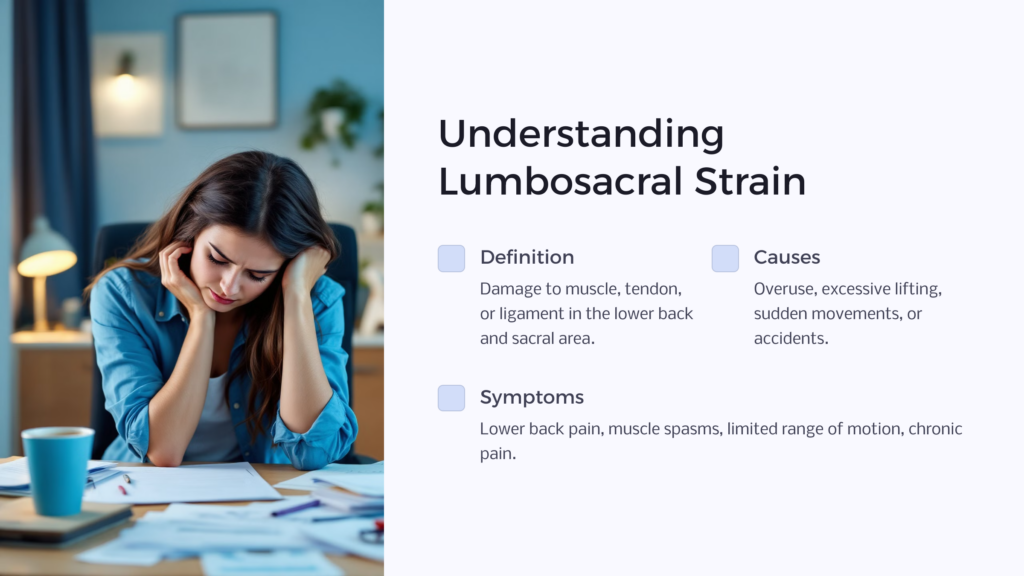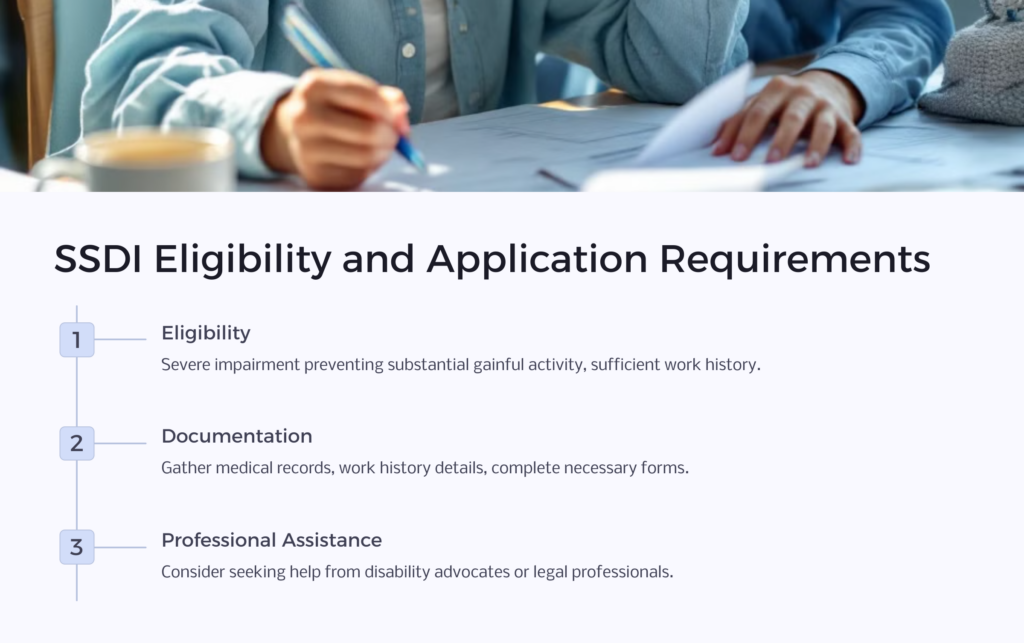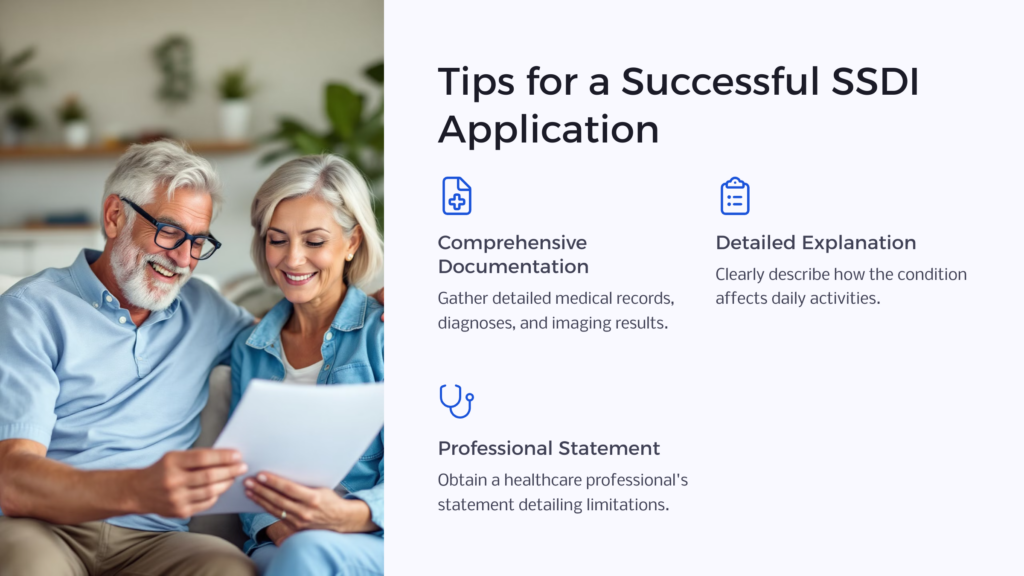Lumbosacral strain is a common condition that can cause significant low back pain and limitations in daily life. For individuals experiencing lumbosacral strain, understanding the process of applying for disability benefits and determining eligibility for Social Security Disability Insurance (SSDI) is crucial. This article aims to provide comprehensive information on lumbosacral strain, its qualification as a disability according to the Social Security Administration (SSA), and guidance on the SSDI application process. By exploring the causes, symptoms, risk factors, eligibility criteria, application requirements, and helpful tips, individuals with lumbosacral strain can gain the knowledge needed to navigate the disability benefits system effectively.
What is Lumbosacral Strain?

Lumbosacral strain is a medical condition that involves damage to a muscle, tendon, or ligament in the spine, particularly the lower back and sacral area. It typically occurs due to overuse, excessive lifting, sudden movements, or accidents. Common symptoms of lumbosacral strain include lower back pain, muscle spasms, limited range of motion, chronic pain, and difficulty performing daily activities.
The lumbosacral region, consisting of the lumbar spine and sacrum, is particularly vulnerable to strain or a muscle spasm due to its crucial role in supporting the upper body and facilitating various movements. Factors such as weak abdominal muscles, a sedentary lifestyle, obesity, and improper body mechanics can also contribute to the development of lumbosacral strain.
Proper body mechanics, maintaining a healthy weight, and regular exercise to strengthen abdominal muscles, paraspinal muscles, and the vertebra of your spine can help prevent this condition. Understanding lumbosacral strain and the causes, symptoms, and risk factors involved proves essential in recognizing its impact on an individual’s ability to work and function.
Is Lumbosacral Strain Considered a Disability by Social Security?

Determining whether lumbosacral strain qualifies as a disability according to the SSA involves meeting specific criteria outlined in the Blue Book, which is the SSA’s official guide to evaluating disabilities.
Several musculoskeletal disorders are classified as disabilities due to their significant impact on a person’s physical functioning and daily activities. One such disorder is rheumatoid arthritis, an autoimmune condition characterized by chronic pain, inflammation and joint damage. It can cause severe pain, stiffness, and limited mobility, often leading to disability.
Another example is muscular dystrophy, a group of genetic disorders that progressively weaken and degenerate muscle fibers, resulting in muscle wasting and functional impairment. These disorders often require comprehensive management, including medical treatment, physical therapy, assistive devices, and adaptive strategies to enhance the quality of life for the patient and promote independence.
Lumbosacral strain is not usually considered a disability, but it may qualify for SSDI benefits if it significantly limits an individual’s ability to perform substantial gainful activity for at least 12 months. The severity of the injury or strain, supported by medical evidence, functional limitations, and the impact on daily activities, is assessed to determine eligibility.
Understanding SSDI: Eligibility and Application Requirements

To qualify for SSDI, individuals must meet certain eligibility requirements, including having a severe injury or impairment that prevents substantial gainful activity (SGA) and having worked long enough and recently enough to be insured for SSDI benefits. The application process involves gathering medical documentation, work history details, and completing the necessary forms accurately.
It’s recommended to seek assistance from professionals or disability advocates to navigate the complex application process and increase the chances of a successful claim.
Tips for a Successful SSDI Application for Lumbosacral Strain

When applying for Social Security Disability Insurance (SSDI) benefits for lumbosacral strain, there are several tips to increase the chances of a successful application. First, gather comprehensive medical documentation, including diagnoses, treatment history, and imaging results, to substantiate the severity and impact of the condition.
Clearly explain and provide examples of how lumbar strain affects daily activities, such as a muscle spasm interfering with walking, sitting, or lifting objects. It’s important to follow the prescribed treatment plan for your lower back pain and provide evidence of compliance.
Consider obtaining a statement from a healthcare professional detailing the limitations and functional restrictions caused by the condition. Seek assistance from disability advocates or legal professionals who specialize in SSDI claims to navigate the application process effectively and maximize the chances of a favorable outcome.
Resources and Support for Individuals with Lumbosacral Strain
Individuals with lumbosacral strain can benefit from various resources and support networks available to assist them. This section will provide information on rehabilitation options, including physical therapy and low back pain management techniques, that can help improve function and alleviate symptoms of lumbar strain. It will also highlight support groups, organizations, and online communities that offer guidance and advocacy.
There are various resources and support available for individuals with lumbosacral strain to manage their condition effectively. Seeking guidance from healthcare professionals, such as orthopedic specialists, sports medicine specialists, physiotherapists, or pain management specialists, can provide valuable muscle strain treatment options and rehabilitation techniques.
Physical therapy, back sprain treatment, and exercises tailored to strengthen the core muscles and improve posture can be beneficial. Sometimes you may receive a prescription for pain medication of muscle relaxants to alleviate pain. Additionally, support groups or online communities focused on musculoskeletal disorders offer a platform for sharing experiences, coping strategies, and emotional support.
Occupational therapists can provide guidance on ergonomic modifications at work or home to alleviate strain. Assistive devices like lumbar support cushions or braces can also provide relief. Finally, staying informed about available resources and disability rights can help individuals access necessary accommodations or financial assistance.
Contact us here at Benefits.com. We would love to help you navigate this process of getting the Social Security disability benefits you deserve!
 Benefits.com Advisors
Benefits.com Advisors
With expertise spanning local, state, and federal benefit programs, our team is dedicated to guiding individuals towards the perfect program tailored to their unique circumstances.
Rise to the top with Peak Benefits!
Join our Peak Benefits Newsletter for the latest news, resources, and offers on all things government benefits.




















